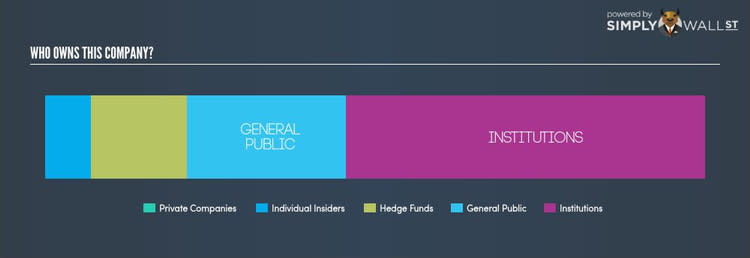Who Are The Largest Shareholders In Premier Asset Management Group Plc (AIM:PAM)?

I am going to take a deep dive into Premier Asset Management Group Plc’s (AIM:PAM) most recent ownership structure, not a frequent subject of discussion among individual investors. The impact of a company’s ownership structure affects both its short- and long-term performance. Differences in ownership structure of companies can have a profound effect on how management’s incentives are aligned with shareholder returns, which is why we’ll take a moment to analyse XYZ’s shareholder registry. All data provided is as of the most recent financial year end.
Check out our latest analysis for Premier Asset Management Group
Institutional Ownership
Institutions account for 54.35% of PAM’s outstanding shares, a significant enough holding to move stock prices if they start buying and selling in large quantities, especially when there are relatively small amounts of shares available on the market to trade. Although PAM has a high institutional ownership, such stock moves, in the short-term, are more commonly linked to a particular type of active institutional investors – hedge funds. Hedge funds, considered active investors, hold a 14.57% stake in the company, which may be the cause of high short-term volatility in the stock price. We should dig deeper into the company’s ownership structure to find how the rest of its ownership structure can impact its investment case.
Insider Ownership
Insiders form another group of important ownership types as they manage the company’s operations and decide the best use of capital. Insider ownership has been linked to better alignment between management and shareholders. PAM insiders are also influential stakeholders with 6.96% ownership in the company. An insider stake of this level indicates that executives are highly aligned with the shareholders as both stand to gain when the value of the company rises. However, it would be interesting to take a look at their buying and selling activities lately. Buying may be sign of upbeat future expectations, but selling doesn’t necessarily mean the opposite as the insiders may be motivated by financial needs or they are simply diversifying their risk.
General Public Ownership
A substantial ownership of 24.07% in PAM is held by the general public. This size of ownership gives retail investors collective power in deciding on major policy decisions such as executive compensation, appointment of directors and acquisitions of businesses. This level of ownership gives retail investors the power to sway key policy decisions such as board composition, executive compensation, and potential acquisitions. This is a positive sign for an investor who wants to be involved in key decision-making of the company.
Private Company Ownership
Another important group of owners for potential investors in PAM are private companies that hold a stake of 0.05% in PAM. These are companies that are mainly invested due to their strategic interests or are incentivized by reaping capital gains on investments their shareholdings. However, an ownership of this size may be relatively insignificant, meaning that these shareholders may not have the potential to influence PAM’s business strategy. Thus, investors not need worry too much about the consequences of these holdings.
What this means for you:
Are you a shareholder? With significant institutional ownership, including active hedge, existing investors should seek a margin of safety when investing in PAM. This will allow an investor to reduce the impact of non-fundamental factors, such as volatile block trading impact on their portfolio value. If you’re interested in bolstering your portfolio with new stocks and are looking for ideas, take a look at our free app to see my list of stocks with a strong growth potential.
Are you a potential investor? Ownership structure should not be the only focus of your research when constructing an investment thesis around PAM. Instead, you should be evaluating fundamental factors like the relative valuation of PAM, which is an important driver that determines PAM’s share price. Take a look at our most recent infographic report on PAM for a more in-depth analysis of these factors to help you make a more well-informed investment decision.
NB: Figures in this article are calculated using data from the last twelve months, which refer to the 12-month period ending on the last date of the month the financial statement is dated. This may not be consistent with full year annual report figures.
To help readers see pass the short term volatility of the financial market, we aim to bring you a long-term focused research analysis purely driven by fundamental data. Note that our analysis does not factor in the latest price sensitive company announcements.
The author is an independent contributor and at the time of publication had no position in the stocks mentioned.

